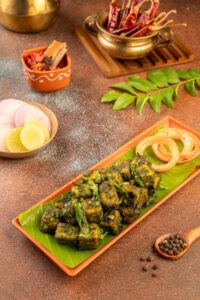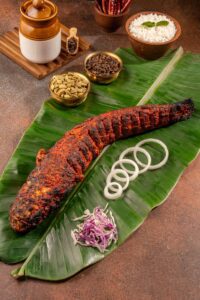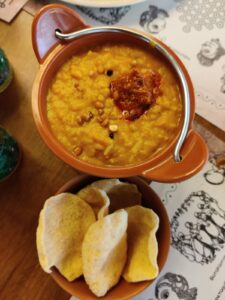
Hyderabad's UTK opens it's first outlet in Bengaluru. (Supplied)
My knowledge of Andhra cuisine is limited to the famous Hyderabadi biryani and the scrumptious Andhra meals – both of which are weekend indulges for me and a lot of people I know in the city.
Also, popular opinion insists that Andhra cuisine stands superior among the rest of the South Indian cuisines for its melange of flavours, liberal use of spices, varieties and use of locally grown ingredients.
Ruminating over my familiarity with this regional cuisine, I went to meet Teja Chekuri, foodpreneur with over 15 brands to his name, for lunch, at the first outlet of United Telugu Kitchens (UTK) in Forum Mall at Konanakunte.
Two days after the launch, at least 10 tables were full at this 180-seater fine-dine space.
“Why did you want your first space to be at a mall?” I asked Chekuri, hinting at Bengaluru’s commuting troubles, especially to get to South Bengaluru.
“Well, consider it just a beginning. We have six more outlets planned for Bengaluru,” he laughed.
This is the third UTK to open in India after Vijayawada and Hyderabad. Chekuri hopes to shake up the Andhra food scene in the city.

Six more UTK outlets expected to open in the city soon. (Supplied)
“Bengaluru is a good city to start anything, not just food. Here, acceptance is more, people are forgiving, the culture is vibrant as the whole country is here. That’s why most start-ups are here. It’s easier to handle business in Bengaluru than any other part of India,” Chekuri noted.
With an extensive menu comprising over 300 dishes, and a fine dining space, Chekuri is positive that UTK will stand out among the Andhra brands that are prominent in the city.
Each section in the UTK menu is divided into two – classics and authentic. Under classic, you will find the usuals such as Chicken 65, Chilli Chicken etc. prepared in Andhra style. The authentic section, as the name suggests, comes with some of the traditional dishes made using home recipes popular in Telugu households.
“All over the country as well as abroad, the demand for South Indian food is at an all-time high. Compared to other cuisines, here each dish is different, prepared differently and has a distinct flavour. Even though the prep time is more, it’s completely worth it,” he shared.
For starters, we are served the Paya Shorba. Cooked with aromatic spices, the thin lamb soup is something that goes straight to your soul, we joked. Then came a barrage of appetisers. Konaseema Paneer – cubed paneer deep fried and coated in flavourful curry leaf paste; Kamju Pitta Roast– Quail bird fried and roasted with selected spices; Andhra Chepa Pulusu Bites— chunks of fish in tangy Andhra style tamarind gravy; Chitti Royyala Boondi Vepudu– tiny shrimps fried and combined with spicy boondi in a curry leaf paste.

Konaseema Karivepaku Paneer. (Supplied)
“The shrimp we use is small river shrimp. It’s rare to get here. The one from farm tastes rubbery. In this one, you can taste the meat,” Chekuri told South First.
The Guntur Lamb Chops we tried next was too spicy for my palate. With a smirk, Chekuri shared that they have toned the spice down for many dishes in Bengaluru.
“People here don’t have the spice tolerance the way people in Hyderabad and Vijayawada do. So we have reduced the spice levels,” he says. There are six varieties of lamb chops available here, he added.
Next, I tried Sora Puttu, which is finely shredded baby shark. Named Chepala (fish) market, an entire section in the menu is dedicated to seafood.
“Most Indian restaurants hesitate to explore seafood because it’s hard to prepare and source. The shark meat here for instance will melt in your hands. It has to be cooked at one particular temperature. It can’t go up or down,” he said, adding that they source all their seafood produce from Bhimavaram, West Godavari district of Andhra Pradesh.

Avakai Korameenu (Supplied)
A platter of a large Vanjaram fish came next. Apty, the dish is called Whole Fish- one of the main highlights here, I’m told. You can choose from Murrel, Sea Bass or Seer Fish which will come marinated and tandoor-grilled in your choice of avakkaya, gongura or traditional masala.
I’m reminded that we haven’t entered the main course yet. As we take a breather, I prod Chekuri, who believes his entry into the F&B space was accidental, about his entrepreneurial journey.
“I was in the US, working in the IT sector for 13 years. I started my journey with Prost brew pub in Bengaluru in 2012. Then started a South Indian restaurant Godavari in the US in 2015, then Ironhill (India’s largest microbrewery)… and so on. There are 15 brands and over 80 outlets now. In 2024, 20 more are being planned,” he shared.
That would make it a hundred! He politely laughed.
The main course started to arrive. There is Ulavacharu Egg Biryani (a robust combination of horse gram and rice topped with deep-fried eggs), Ulavacharu Chicken Biryani (with Chicken baked in horse gram gravy), and Shahi Gosht Biryani (juicy mutton in a creamy marinade).

Muda Pappu Avkai Annam. (Supplied)
Among the UTK favourites, we tried the classic Muda Pappu– Avkai Annam, which won my heart at the first bite itself. The comforting blend of soft lentils and rice, spiced with mango pickle could be your any day-any time meal.
As I tried, what I insisted would be my last dish, the Mutton Sankati– millet dumplings with spicy mutton curry, I asked Cheturi if running so many outlets comes with its challenges.
“In India, there’s no focus on the system. For example, there should be a control over the recipes of the dishes. There is a certain cleaning liquid that has to be used in the restaurant. It should be the same in the kitchen as well as the dining space. Most traditional restaurants in India don’t follow all these. They go by situations. But if it’s a system-driven business, it runs itself. So it becomes easier to expand,” he shared.
That said, there is still a challenge to maintain consistency.
“No matter how much you fine tune it, consistency is still a challenge. You need to monitor your out lets closely, keep a check on reviews and feedback. Quality control is a must,” he added.
Up next, UTK will open in New Delhi.
“There is a lot of vacuum for South Indian-owned South Indian restaurants there. So we are going to tap that market gap,” Chekuri is hopeful.
On that note, the dessert arrived. We have the Coconut Jaggery Ice cream which surprisingly wasn’t overly sweet and the Gulab Jamun Ice cream which more than made up for it.

Jul 26, 2024

Jul 26, 2024

Jul 25, 2024

Jul 21, 2024

Jul 20, 2024

Jul 20, 2024